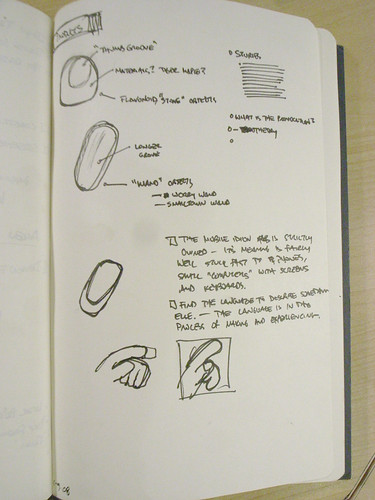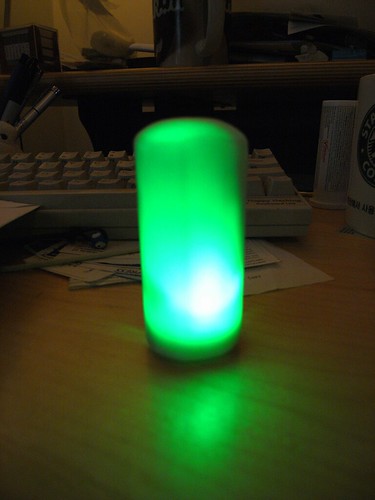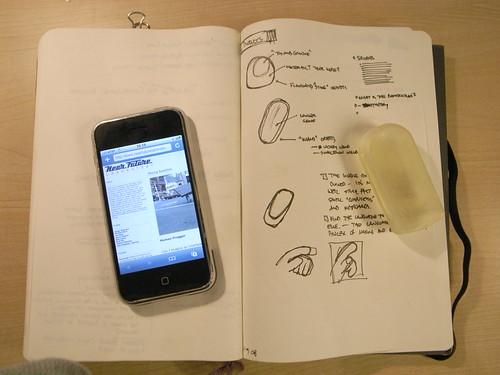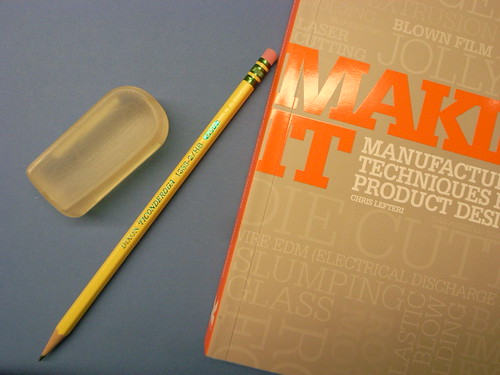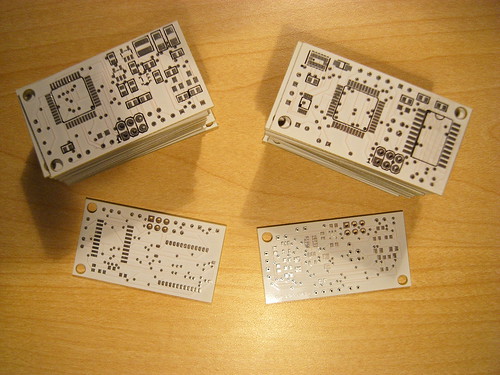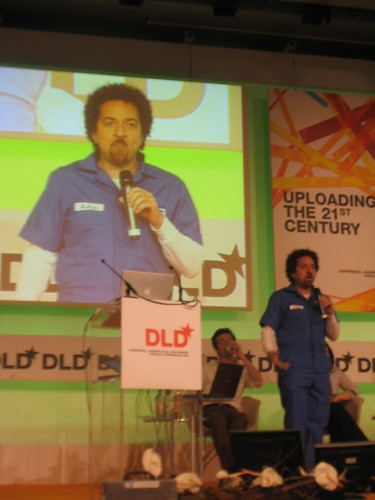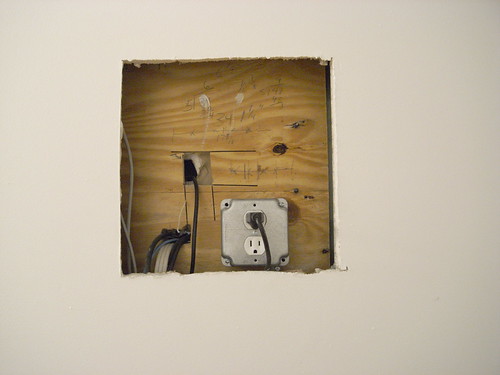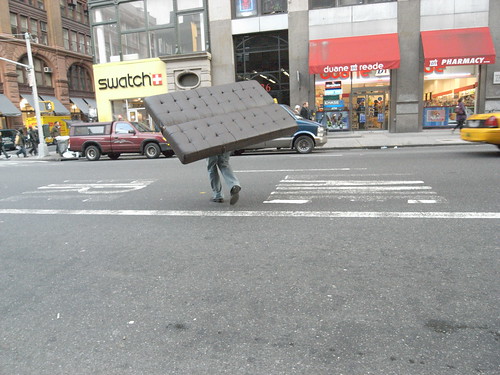This is a quick, quick sketch for an idea I had for a intimate personable device that is best described as a digital worry bead or Kombolói — not so much a worry bead as something to capture and diffuse your anxiety. It works by capacitively linking your tension through a unique capacitive touch sensor and then harnessing that energy, turning it into light and then diffusing it into more soothing energy.
It’s just an idea I had on the plane. I don’t think I was having an anxious feelings on the plane, but I thought — what would an “activated” (digital/electronic) version of the Kombolói look like? What would it do? What would it make me feel?
I happened to see a few of these over the last couple of months in peoples’ palms — maybe some where actually prayer beads. And in at a breakfast meet-up with Linda Stone last week in Munich at DLD08, I learned of some of her very interesting vectors of research beyond her fascinatingContinuous Partial Attention that has to do with the deleterious physical downsides to simply reading email. (Evidently, we go into the wrong sort of state when engaging in what can be an anxious moment — opening your email program. We hold our breath and/or our breathing state goes into a non-flow state that has these terribly noxious effects on our body chemistry. The various levels of oxygen and nitrogen and all kinds of things I should’ve learned more about if I had paid attention during high school biology — they just go nuts with really bad consequences. Who would’ve known? Well, Linda does, and so does the NIH which is taking this stuff seriously.)
I wanted to find a way to make it luminesce brightly. I’m still working on that — because of the fittings inside and the printed circuit board, etc. — it’s proving difficult to make it glow exceptionally bright, and without shadows. I may have to lower my expectations and change things around in some fashion. Perhaps only a small part of the object will glow. I’m also thinking about ways to make the interior reflective to bounce light around and mitigate the effects of shadows on the surface.
I started with a simple form for the object that was quite small, just to try it in the hand. Generally, people thought the shape and form was right in this early shape. I sort of awkwardly modeled the form in as few strokes as possible, but clearly I need to learn how to be more patient with the modeling stage of the sketch, including allowing myself multiple steps for each larger feature — sketch, revolve, cut, extrude steps, for example, for just one articulation in the form. In other words, just getting the basic overall shape and then cutting away to get more detail. I had been trying to get most of the form in one quick step, with an extrude or whatever, and not paying attention to where tangents were falling, etc. For example, when I started with this form (the small thumb-sized transparent model below) and then moved to a second version (the white plastic one above) I tried to make small improvements to account for the engineering that had to happen inside (mountings, slots, clips, etc) and ended up breaking many of the external features, and making hard points that defeated my goal of a smooth, informal form.
This of course yet another mechanism through which I am exploring how Touch, Motion and Time can become the basis for experiencing different sorts of interactive experiences. My conceit is that these are elemental forms of human experience that are largely dismissed in the digital era, but they are crucial and distinct aspects of how we humans experience and make sense of the world around us. So, to understand this more completely, and to have a stronger basis for discussing it and creating new things that are more than button clicks and mouse florishes, I have been making some template components that articulate these elements in various ways. This is just one more that occurred to me a couple of weeks ago. The touch aspect of these Kombolói — that you hold them and they can be seductive enough in the hand to compel you to roll them in your palm or run your thumb along them as a gesture that soothes and calms; the motion of moving them around and such in the same fashion; and the durational aspect of them, that you spend time, slowing yourself and focusing and loosing yourself as time passes and as you begin to relax, rather than the immediate and instantaneity of many digital and networked interactions — these all seemed to be captured in this social object. So, the question is — what would be a way to explore these elements in my small catalog of devices?
I made a variation of the template component I’ve been making for many months now. This time, I tried to find some simplifications and tweaks to change the geometry of the component. Yet again. (Sigh..) The process of iterating these designs is both exhilirating and exhausting. I end up taking very similar electrical schematics and sweeping them through physical changes, moving components around in the printed circuit board to try and compress things, sourcing alternative replacement components or learning new little tradecraft tricks.
I quickly redid some circuits and board layouts on the flight back and got the form factor down to a geometry that’s got one long axis and was as narrow as I could make it. I’m still trying to find easy ways to program the ATMega microcontroller without taking up a big footprint on the circuit board. Haven’t quite found the right way yet. But, I’ve foregone putting the FT232RL device on the board, which was the rather large chip to do USB to serial conversions. Very convenient, but very large. My strategy now, such as it is, is to use a small external breakout board that the FTDI people manufacture that does the same thing, only with a much smaller footprint version of that chip (one that’d be a challenge to place by hand on my board) and which includes a mini USB connector on it. So, using that breakout board, I only need to run a few wires to it, and I can put it off to the side in the device with a simple mounting bushing or slot into which it fits.
The overall design is meant to be something that feels good to hold — comforting or soothing.
Moving Forward
There’s a strange anomaly with the electrical circuit that I need to figure out — it appears to drain the battery completely even when it is “off.” I have a kind of untested mechanism for shutting off power to the main logic rail (VCC) while keeping the output of the regulator powering the real-time clock’s battery backup input so that it maintains the time. Perhaps there is a problem there, although I’m a bit puzzled that this design would cause a problem. This part of the design process is less interesting to dwell on, so I won’t. Suffice it to say that there is some problem, and part of documenting the design process is to mention and ponder problems, so, well..there you go.
I also had some good feedback from folks yesterday regarding some technical issues and design issues. It seems that the illumination aspect is still a bit krufty — it’s tricky to illuminate the body, particularly with the translucent material, because because of the shadows cast by the internal parts. I am going to try making some sort of light guide to help mitigate this problem — perhaps a tube or some such that runs along the long axis of the part. Jed suggested this, and it immediately made good sense. Something that caps at the LED and fits on it. Also, this provision for two LEDs — one on either end, facing towards each other — means that I can make the light guide attach to both of them along the long axis.
Semaphore Communication
For communication to the data network, I am thinking about a color-based semaphore system using the built-in camera that many computers come with. The idea is that a simple color sequence can relay certain information could encode the state of the device which could be interpreted by a simple Processing sketch or something. It wouldn’t communicate the kind of robust information that the current firmware is able to do over USB (or..maybe it could?), but it would be a compact mechanism for doing this, and eliminate the necessity for USB hardware and so forth. I’m looking forward to exploring this further. We were discussing it in relation to Veronica Perdes class project on this very exciting idea of a "Fugitive Object" and how we could create a simple mechanism for communication back to the mothership.


